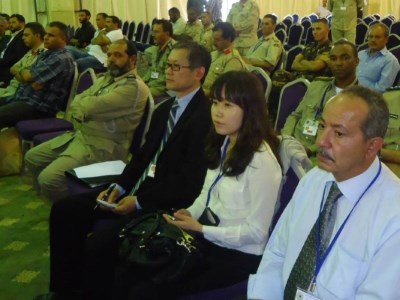China seeks to meet the global challenges of the new technology revolution and to assert its superiority in efforts to enhance its missile defense capabilities. In this regard, it will present the new missile system named "Red Flag-19 Hongqi"
during the upcoming Zhuhai Air Show 2024.
The HQ-19 system combines a number of modern technologies that reflect the extent of China's developments in the field of missile defense to deal with ballistic missile threats inside and outside the atmosphere, especially since its design is similar in concept to the American THAAD-ER system.
Its development dates back to the late 1990s as part of China’s 863 Program, which prioritized advances in high-tech defense capabilities. In February 2021, China’s Ministry of National Defense announced a test that confirmed the HQ-19 met all expectations after passing a series of tests from 2010 to 2021, emphasizing its defensive nature. In June 2022, China conducted a land-based technical test of a mid-course anti-ballistic missile, with analysts saying the successful interception demonstrated the reliability of the country’s anti-ballistic missile umbrella. The system is not directed at any specific country and is primarily designed to intercept ballistic missiles that might reach it.
The HQ-19 missile defense system is believed to operate using a "hit-to-kill" technology, which is typical of interceptor missiles and is closest to the kinetic kill vehicle technology. It focuses on intercepting short- and medium-range ballistic missiles during their final phase (re-entry phase), at ranges of up to 200 kilometers, and at an altitude of 150 kilometers, and destroying them by directly colliding with them using pure kinetic energy. They usually do not carry an explosive warhead. China has achieved a high kinetic kill capability, as demonstrated by its Red Flag 19 supersonic system.

Kinetic kill vehicles are known to be projectiles that rely solely on the high kinetic energy of the projectile to inflict damage on the target, rather than using any explosive, incendiary, chemical or radioactive payload. The theory of operation of these weapons is based on achieving a high flight speed - generally faster than sound or even reaching supersonic speed - to collide with their targets, and converting their kinetic energy and relative momentum into destructive shock waves and high heat.
The HQ-19 system is characterized by With a set of technical features that make it work effectively, it uses a cold launch mechanism at a very high angle of inclination, and this mode enables it to accurately intercept enemy ballistic missiles. The 610A information radar integrated with the command system and attached to the system can detect and track enemy targets at distances of up to about 4,000 km, which means that it covers large areas from North South Asia to the interior of China. With the continuous development of Chinese missile technology, China is expected to continue to improve and develop the HQ-19 system, which enhances its capabilities and makes it more effective in confronting modern threats, especially since China has achieved a remarkable ability in kinetic killing technology, as it is the second country to develop this approach after the United States. Multiple tests have proven the success of HQ-19 missiles in intercepting at an altitude of more than 200 kilometers and relative speeds of up to 10,000 meters per second.
Details remain confidential, however, there are some leaks reported by specialized media about the system, and reports indicate that the HQ-19 system is more distinguished than its counterparts, and that the HQ-19 interception range reaches 3,000 kilometers, allowing it to engage ballistic missiles within this range, including their enemy warheads, which greatly increases the probability of successful interception while reducing the risk of collateral damage.
The system consists of mobile launch units, radars for detection and positioning, and command centers for controlling operations and executing orders. In addition to the HQ-19 launcher, with complementary systems such as the HQ-9 and HQ-26, the HQ-19 phased array radar provides early warning capabilities that support multi-layered missile defense. The radar coverage and interception capabilities of the system make it a countermeasure against potential regional threats, including ballistic missile systems from neighboring countries.
One of the most important factors in the success of the missile is the guidance system it uses. The accuracy of the missile hitting the target is a decisive factor in its impact and success. Therefore, the missile's guidance system is considered one of its most important features. The HQ-19 missile is similar to the THAAD system and is equipped with an infrared seeker in a side window. The window design can reduce the effect of atmospheric friction and heat on the detection of the infrared sensor, giving the missile the ability to intercept in the atmosphere and provide accurate targeting at high altitudes. It can use a lighter kinetic energy seeker to increase the height and range of the interceptor missile.
The missile is powered by a two-stage solid rocket motor, which includes a carbon fiber body and N-15B solid fuel. This configuration provides a specific pulse for 260 seconds, supporting high maneuverability to intercept warheads on the move. The rocket motor design features a dual pulse capability, which improves the effectiveness of the terminal kinetics, allowing the missile to maneuver flexibly during interception.

In February 2021, China's Ministry of National Defense announced a test that confirmed that the HQ-19 meets all expectations, especially since China conducted several such tests from 2010 to 2021, emphasizing its defensive nature. In June 2022, China conducted a land-based technical test of an anti-ballistic missile in mid-course, with analysts saying the successful interception demonstrated the reliability of the country's anti-ballistic missile umbrella. The system is not directed at any specific country and is primarily designed to intercept ballistic missiles that may reach it. The announcement of the HQ-19 missile system comes as an important step in modernizing the Chinese army's air defense capabilities.
The HQ-19 system ranks as the latest Chinese product competing with the American THAAD missile system, the S-400 system, the Indian Agni-4 and Agni-5 systems, the Israeli Arrow system, and the South Korean Cheongung II system. It even outperforms them and announces to the world the launch of the Chinese dragon in this vital field, which represents part of the broader Chinese national strategy to enhance its security and protect its airspace as an important step in modernizing the Chinese army's air defense missile capabilities.












 English
English  العربية
العربية 








